The Boy Jesus at the Temple
Luke 2: 41-50
The boy Jesus at the Temple DIG: What was the significance of these feasts that was an annual tradition with the Lord’s parents? Make a list of Yeshua’s character traits revealed in this passage. What do they tell us about the kind of youngster Jesus was? How much does He seem to know about His mission? How much do His parents know? How much did His parents seemingly forget?
REFLECT: In balancing your hunger for God with your daily responsibilities do you err more on the side of neglecting the Lord or the other concerns? Why? What would a proper balance look like to you? What are some of the questions you have for Him right now? When you don’t get an immediate answer, what do think? Do you have the assurance that He is listening? Do you accept the possibility that He may say no?
Every year Yeshua’s parents went up to Jerusalem. On the fourteenth of Nisan every able bodied Israelite man not in a state of uncleanness was to appear in Yerushalayim for Pesach. Though women were not obligated to go up we know from Scripture (First Samuel 1:3-7), and from the rules laid down by Jewish authorities (see Josephus, Wars, vi. 9-3; and the Mishnah Pes.Ix. 4), that their attendance was common. Indeed, it was a joyous time for all Isra’el. From all parts of the Land and from foreign countries the festive pilgrims came in groups, singing their pilgrim psalms, and bringing with them burnt and peace offerings, according to how ADONAI had blessed them; for none might appear empty before Him. Josephus records that the number of people in the City would swell from the usual 500,000 to about three million.191
Without being named directly, this is the last time that Joseph, the earthly stepfather of the LORD, is in the picture. The imperfect verb went indicates that it was the habit of Jesus’ parents to go up to the City of David to celebrate Pesach. Every year also emphasizes this point. Jerusalem is a higher elevation than Nazareth; therefore, they had to go up to get there. The Passover was one of the three annual feasts, Passover, Weeks, and Booths, Jewish men were required to celebrate (Deuteronomy 16:16).
The parents of Yeshua traveled to Zion every year for the Feast of the Passover in keeping with the commandments found in Exodus 23:14-17 and Deuteronomy 16:1-8. This demonstrated their obedience to the Torah. But, traveling alone or as a family was dangerous because of thieves and murderers on the road. So, when traveling long distances, people usually traveled in caravans for company and protection. A day’s journey was about twenty to twenty-five miles. Luke, under the inspiration of the Ruach Ha’Kodesh, feels compelled to record when Jesus was twelve years old, His parents went up to the Feast, according to the custom (Luke 2:41-42).
When Yeshua was younger His parents went up to Jerusalem without Him. But, now it was time for Him to go along with them. The rabbis taught that the son was to be taken to Jerusalem as a preparation for his bar mitzvah when he was thirteen (Pirke Avot 5.24). In keeping with that Jewish custom, His parents took Him to the City of David when He was twelve years old. At thirteen, a Jewish boy was called a bar mitzvah, or a son of the commandment (Nid. 5:6; Nazir 29b), the age of accountability, when he would take on the responsibilities of adulthood. Therefore, Jesus would have undergone a rigorous program of instruction and preparation for this passage to manhood. But, the modern bar mitzvah ceremony and celebration evolved from Jewish customs in the Middle Ages, so we can only guess as to how Jews celebrated in the first-century. There is little doubt, however, that Luke’s account records this event because it served as an important transition in the life of Yeshua as a traditional Jew.192
Pesach lasted but one day, and was immediately followed by the feast of Unleavened Bread for a total of eight high holy days (Exodus 23:15; Leviticus 23:4-8; Deuteronomy 16:1-8). Together, they were commonly called the Passover. Only the first two days of the eight-day festival was personal attendance in the Temple Mount mandatory. The third day started the so-called half-holidays, when the pilgrims were permitted to return home. And many did so, including the caravan from Nazareth. There was really nothing of special interest to detain the pilgrims any further. The Passover meal had already been eaten, the second Chagigah offering had been sacrificed (The first being sacrificed as a representative for the sins of the nation, slaughtered in the Temple grounds at 9:00 am on the fifteenth of Nisan), and the first ripe barley had been reaped, brought to the Temple and waved as the Omer of first flower before Ha’Shem after the Sabbath.193
So Mary and Joseph began the journey north to Galilee along with hundreds of other pilgrims, probably including dozens of friends and relatives. And as the whole caravan was returning when they had fulfilled the two necessary days, the boy Jesus stayed behind in the City. But His parents were unaware of it (Luke 2:43 NASB). The caravan probably went around Samaria, on a path that could only be described as treacherous. There were few inns or sources of food and water, and the landscape alternated between desert and rugged wilderness. But, there was safety in numbers so Miryam and Joseph’s fellow travelers were hardly strangers, for they made this same journey together each year.194
Anxiety struck Mary and Yosef when they realized that they had lost track of their son. They experienced first hand the panic that overcomes a parent when a child disappears at a department store or fails to arrive home on time from school. How did this mix-up happen? The women normally traveled with the younger children on such a journey, separate from the men and older boys. But, Yeshua was twelve years old, and gradually moving from the care of His mother to the training of His father. During that transition, a boy could opt to travel with either parent. Evidently each of His parents thought that Jesus had gone with the other. It was an honest mistake.195
Thinking He was in their company, they had traveled on for a day. Caravans of this day traveled about twenty miles a day. Then they began looking for Him among their relatives and friends (Luke 2:44). The imperfect tense denotes thoroughness and repeated action. They repeatedly walked the length of the caravan in search of their lost son, growing more concerned by the moment, pleading with fellow pilgrims for some clue as to their son’s whereabouts. But, not a single person could remember seeing Yeshua since the moment the endless column of travelers left the City of David.196 When they did not find Him, they hurriedly retraced their steps and went back to Yerushalayim to look for Him (Luke 2:45). A second full day was spent returning to Jerusalem.
Somewhere, among the merchants, soldiers and exotic travelers in the crowded, hectic City, they had to find their son. As the third day started and the so-called half-holidays had begun, things started to return to normal in the Holy City. The soldiers had returned to their barracks in the nearby Antonia Fortress, allowing the worshipers to return to their normal routines of prayer, fasting, worship, sacrifice and teaching. Jesus was in His element.
Yeshua was probably quite aware that His parents had already begun the journey back to Nazareth. He was not insensitive, but, His thirst to share His insights were so great that it probably never crossed His mind that Miryam and Yosef would be worried once they discovered Him missing. Nor does Yeshua believe His actions were disobedient. But, the things of God overwhelmed every other consideration. Like all Jewish boys, He was growing into manhood. But, Jesus was far different from all the other Jewish boys His age.197
Meanwhile, Mary and Joseph frantically searched the narrow streets and bazaars of the Lower City. That was the most logical place to start. They just couldn’t understand His disappearance. It just wasn’t like Him to wander off without telling them where He was going. Not finding Him in the Lower City, they went to the Temple Mount itself.
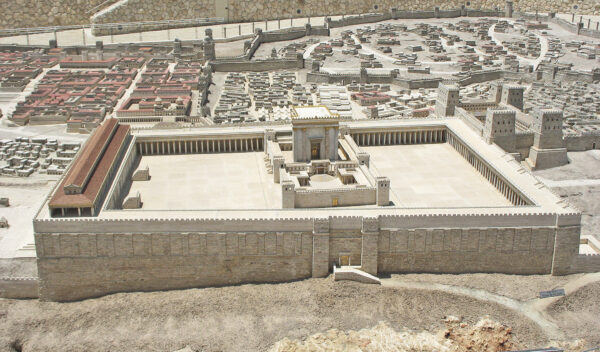
They trudged up the thirty uneven steps as fast as they could go, then through the entrance to the southern Double Gate,
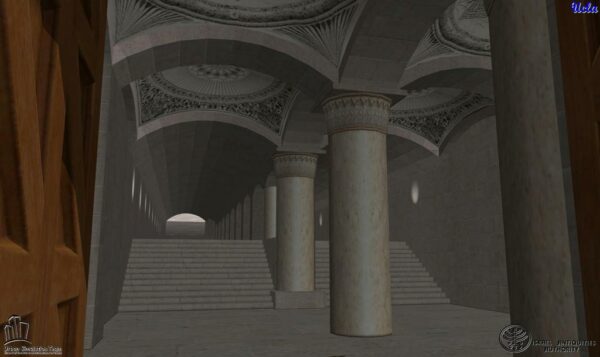
and, at its end, up the stairway to the open-air stone courtyard known as the Court of the Gentiles that covered the majority of the Temple Mount.
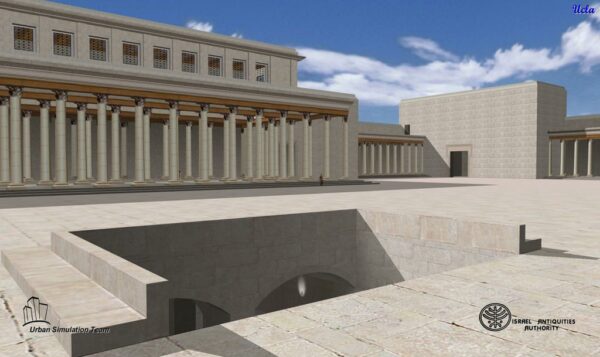
It was a three-acre platform with walls stretching a quarter mile and could have held two amphitheaters the size of the Roman Coliseum. Being five hundred cubits square, it could hold a total of about 200,000 people.198 They found themselves standing on an extremely large crowded plaza, where they begin scanning the many worshipers for signs of their son. It seemed impossible to know where to look first. What should they do next? Where should they go? Moving toward the Sanctuary, they passed through the Beautiful Gate and entered the Court of the Women.
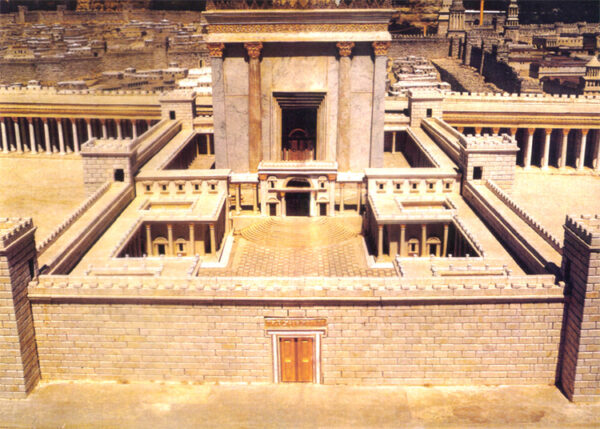 This inner area of the Temple compound was open to both men and women. Certainly, it was the common place for worship for everyone and functioned to a certain extent as a Temple synagogue in the open air. It was a large area that covered 70.87 by 70.87 meters, 5,023 square meters, or 16,475 square feet.199 All around it ran a simple porch 60 feet square. Just a few days earlier at the height of the Passover it was capable of holding up to 6,000 worshipers. But, now with the so-called half-holidays, many of the pilgrims had returned home. It was still crowded enough, however, that it took longer than they wanted to finally come to the conclusion that Jesus was nowhere in sight.
This inner area of the Temple compound was open to both men and women. Certainly, it was the common place for worship for everyone and functioned to a certain extent as a Temple synagogue in the open air. It was a large area that covered 70.87 by 70.87 meters, 5,023 square meters, or 16,475 square feet.199 All around it ran a simple porch 60 feet square. Just a few days earlier at the height of the Passover it was capable of holding up to 6,000 worshipers. But, now with the so-called half-holidays, many of the pilgrims had returned home. It was still crowded enough, however, that it took longer than they wanted to finally come to the conclusion that Jesus was nowhere in sight.
The search had become a process of elimination. Their son was obviously not in the Chamber of the Lepers. The Chamber of the Hearth housed priests while they were on duty and contained only dormitories and offices, so that was unlikely. The Chamber of the Nazirites, that, too, was out of the question. But, Miryam and Joseph were desperate and willing to look anywhere. They scoured the Temple grounds with the same frantic urgency with which they searched the bazaars and alleys of Jerusalem earlier in the day.200 Finally, as a last resort, they went to the Royal Stoa. 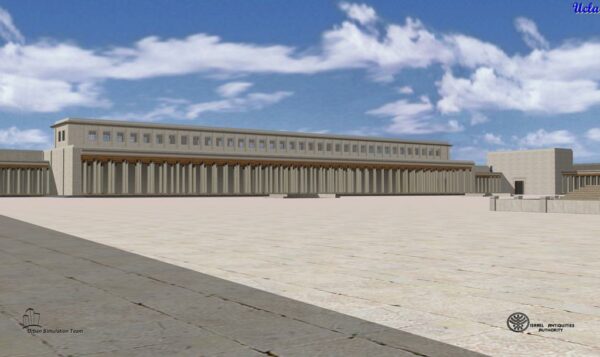 It was a large open-air plaza that ran the length of the entire southern wall. It was built according to the plan of a basilica, or a large structure in ancient Rome. Rectangular in design, it consisted of a roofed hall entered from porticos at each end. It had a wide central aisle, or nave, and was separated from the two side aisles by rows of columns. The nave walls rose above the aisle roofs and were constructed with windows to admit light. It was not a sacred place and was actually an extension of the Court of the Gentiles. The rabbinic description for it was called chanuth or chanuyoth in the Talmud, which means something like shop or market. In the last week of His life, Yeshua would drive out the moneychangers from that very spot (to see link click Iv – Jesus Entered the Temple Area and Drove Out All Who Were Buying and Selling).
It was a large open-air plaza that ran the length of the entire southern wall. It was built according to the plan of a basilica, or a large structure in ancient Rome. Rectangular in design, it consisted of a roofed hall entered from porticos at each end. It had a wide central aisle, or nave, and was separated from the two side aisles by rows of columns. The nave walls rose above the aisle roofs and were constructed with windows to admit light. It was not a sacred place and was actually an extension of the Court of the Gentiles. The rabbinic description for it was called chanuth or chanuyoth in the Talmud, which means something like shop or market. In the last week of His life, Yeshua would drive out the moneychangers from that very spot (to see link click Iv – Jesus Entered the Temple Area and Drove Out All Who Were Buying and Selling).
From 30 AD on, the Great Sanhedrin (see Lg – The Great Sanhedrin) met in the southeastern corner of the Royal Stoa. Earlier in its history, they met in the Hall of Polished Stones on the southern side of the Temple. But the Talmud reports that the Jewish supreme court moved into the Royal Stoa 40 years before the destruction of the Temple in 70 AD.201 Normally, the members of the Jewish supreme court, who sat as a court of appeal from the close of the morning sacrifice to before the evening sacrifice, were occupied all day long. But, there were occasions, like Sabbaths and feast-days, when they would come out onto the colonnade of the Royal Stoa to teach. Those porches were the most convenient places for discussion, religious or otherwise. In such a setting, more latitude for asking them questions would be given. The learners sat on the ground at the feet of the rabbis who were themselves seated in their normal teaching position.202
Even as a young boy, Jesus had clarity regarding His mission. He was on this earth to do His Father’s will. He was sitting among the rabbis, listening to them, understanding them and asking them questions (Luke 2:46). The feast of Unleavened Bread was still being celebrated, because Yeshua could not have been sitting among the rabbis after the close of the Feast. Yet, at the age of twelve He was able to intelligently discuss issues in the TaNaKh and the fine points of the Torah of Moshe with those who where supposedly the experts in its interpretation. Apparently He was asking them questions they could not answer. It was extraordinary that His questions could show such insight as to attract the special attention of the learned rabbis.
Everyone who heard Him was amazed at His understanding and His profound answers (Luke 2:47). The Greek word existanto, used to describe the response of the rabbis is fascinating for two reasons. First, amazed literally means to remove oneself; figuratively it means to lose one’s wits, to go out of one’s mind, or to be terrified out of one’s wits. Today, we would say: They were beside themselves. Therefore, amazed doesn’t really capture the utter astonishment and excitement that seized Israel’s most gifted rabbis. He was a child prodigy. The Greek words point to the fact that Jesus could put concepts together and come up with insights that should have been far beyond the grasp of a twelve year old. He could get to the heart of the issue like no one they had seen. By the age of twelve, Jesus knew that He was the Messiah of Isra’el.
The second reason the use of the word amazed is extraordinary, is that the Greek translation of the TaNaKh, or the Septuagint, uses the same word to describe the reaction of people who had seen ADONAI. Of all the words Luke could have chosen, he used the most theologically loaded word possible. Undoubtedly, his readers didn’t miss the point.203
There were several reasons for their amazement. First was His age, second was His knowledge, but third, Jesus was from Galilee and not from one of the Jewish rabbinical schools in Jerusalem. Last, and even worse, He was from the town of Nazareth, where the schooling was even of less value than that of other Galilean schools. But, in reality, Yeshua had the best training of all (see my commentary on Isaiah Ir –Because the Sovereign LORD Helps Me, I Will Set My Face Like a Flint). He was trained and discipled by God the Father; and therefore, able to carry on an intelligent dialogue with the experts of the Torah. Consequently, all that heard Him were amazed.204
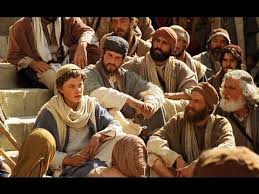
Sitting in the Royal Stoa where some members of the Sanhedrin taught the pilgrims during the Passover, Mary heard His voice. After three days of frantic searching, they found Him safe and sound; calmly listening to the rabbis and asking them questions, seemingly, unconcerned about His parent’s distress. When they saw Him, they were astonished because the words coming from His mouth were nothing like they had ever heard before (Luke 2:48a). Mary and Yosef were shocked at the ease with which their son discussed the things of ADONAI.
Nevertheless, they were understandably irate because they hadn’t seen Him in three days. They were probably worried that He was dead on the side of a road somewhere. So, naturally, they spoke to Jesus like any parent would upon finding a lost child (I’m so relieved I found you, now I’m going to strangle you). Remember, Mary and Yosef were raising a normal healthy boy. He didn’t run around wearing a halo.205 When His exhausted, but, relieved mother finally got to talk to Him, she began to scold Him. She said: Son, why have You treated us like this? Your father (the most natural way of describing Yeshua’s relationship to His step father Joseph) and I have been anxiously searching for You (Luke 2:48b).
When you think about it, Jesus’ reply was probably the last thing she expected to hear: Why were you searching for Me? Didn’t you know I had to be in My Father’s house? The words Me and I are emphatic. Upon first glance, His answer might appear a little disrespectful, but, we can’t hear the inflection of His voice in print. Their frantic searching all day before looking for Him at the Temple genuinely confused Him. If His parents had remembered the words of Simeon and Anna, the Temple should have been the first place they should have looked upon returning to Zion. Where else would the Son of God be but in His Father’s house? But, inexplicably, sometime during the twelve years of Yeshua’s upbringing, the words of the angels, the shepherds, Simeon, Anna, and the magi had all faded. The humdrum of daily life seemed to have washed them away. Mary and Yosef didn’t connect the dots, and didn’t understand what He was saying to them (Luke 2:49-50).206
Within the context of the Jewish family, Jesus was right where He belonged – making the appropriate shift from His mother to His Father to learn and become active in the family business. At the tender age of twelve, the Messiah signaled a turning point in His relationship with His parents. He returned to Nazareth with them and continued to honor them with His obedience (see Bb – And Jesus Grew in Wisdom and Stature, and in Favor with God and Other People). Joseph taught Him the trade of a carpenter. But, the family business Yeshua was to take up belonged to His Father in heaven.207
In 1915 Pastor William Barton started to publish a series of articles. Using the archaic language of an ancient storyteller, he wrote his parables under the pen name of Safed the Sage. And, for the next fifteen years he shared the wisdom of Safed and his enduring spouse Keturah. It was a genre he enjoyed. By the early 1920s, Safed was said to have a following of at least three million. Turning an ordinary event into an illustration of a spiritual truth was always a keynote of Barton’s ministry.
“There came to our home, our Little Grandson. And he sought out his Grandmother Keturah, that she would give him a Roll. And she would have understood him plainly, but he said that he wanted a Pyonder Roll.
Now Keturah can make Pocket-Book Rolls, and Parker House Rolls, and Hot Biscuits, and if there be any kind of Rolls that are good, she can also make them. And when she serves them with Golden Butter and Maple Syrup or Honey or Preserves, they cause the mouth of a Graven Image to water. But, she did not know about any Pyonder Roll.
And the little lad said, I want the Roll that’s called a Pyonder.
Then did a Great White Light begin to dawn upon the mind of Keturah, and she said, Tell me the rest of it, my dear. And he said: When the Trumpet of the Lord shall sound and Time shall be no more. And the Roll is called a Pyonder (From the hymn: When the Roll is Called Up Yonder) I’ll be there. And she gave him a Roll, and he was there.
Now I thought myself of the Strange Mental pictures that our Grown-Up words bring to the mind of children. And I considered that our Heavenly Father knows that our minds also are but the minds of Little Children, and all our Mental Pictures of Celestial Things are limited, as Mary and Yosef demonstrated so well, and that much that we learn of Divine Truth is even as the Pyonder Roll.
And I am thankful that we have our Pyonder Rolls, even our Daily Bread, and that the way of essential righteousness is so plain that a little child may learn of it. And it is my earnest hope that when the Roll is called Up Yonder, I’ll be there.”208



Leave A Comment